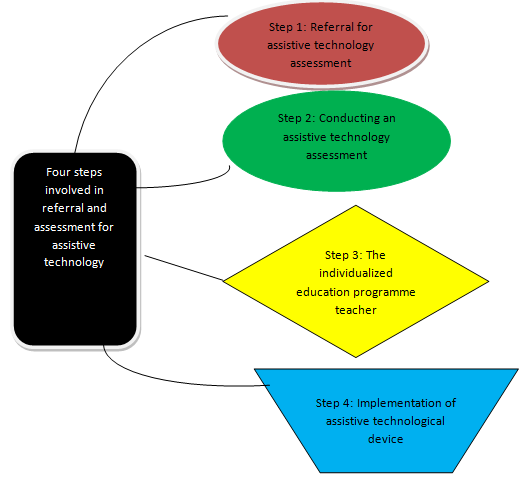Introduction
Assistive technology assessment is an evaluation process carried out on disabled students engaged in learning process (Beard, Carpenter and Johnston, 2011).
The most fundamental role of AT assessment is to generate data on disabled students, which are later used to recommend an appropriate assistive technology device type (AT) to the learner. Notable to mention is that this assessment process must be conducted globally in order to gather information from variety of sources (Beard et al, 2011).

This step entirely relies on information collected from variety of sources worldwide. Such sources include student personal record and information gathered directly through observation by an AT specialist (Beard et al, 2011). Additionally, the AT specialist may also collect information by interviewing the disabled students family members and even fellow friends.
Importance of assistive technology assessment
Conducting an AT assessment is important since it specifically reveals specific special needs for students with disabilities. On the other hand, the assessment also helps in classifying the disabled based on their unique abilities (Beard et al, 2011). Most importantly, family members and friends also help the AT specialist to collect accurate information about the disabled learner.
This is vital especially when making final decision concerning the AT devices type to be recommended for the disabled. The AT assessment also provides an accurate feedback, which best describes the students abilities (Beard et al, 2011). It is also easy for the AT specialist to recommending an appropriate education program teacher to work with the disabled student.
IPad has revolutionalized learning for ASD students
Autism spectrum disorder (ASD) is a complex developmental disability, which precisely affects communication and socialization aspect of life (Autismparenthood, 2012).
Moreover, ASD is a genetic spectrum disorder that can manifests severely in some people while in others it can manifests mildly. It is evident that many students who have ASD face a lot of challenges during learning process. The major challenge they face is communication difficulties with their teachers and other students.
The use of iPad has revolutionalized learning processes for students with ASD. This is because, iPad provides a proper venue for both children and adults with ASD to speak out and be heard. iPad is the best technological gadget recommended to people with ASD.
This is because it is portable and has varieties of applications. Additionally, it is easy to customize most applications on iPad in the best way it can help the non-verbal child to communicate (Autismparenthood, 2012).
It is also possible to download varieties of pictures and symbols, which can guide the child in communication. When the child desires something, it is easy to touch the picture on the screen using the finger and the iPad speaks out. The child can also construct sentences using pictures or symbols in the iPad. The child will only touch several pictures as the iPad reads out. For example “I want to go out” (Autismparenthood, 2012).
According to Autismparenthood (2012), it is evident that iPad helps in transforming the social status of the disabled child, by giving him a chance to speak out. It is also easier for the child to say yes or no to various events.
It is also possible for the child to tell people what to do or what he wants by just pointing at a picture on the iPad screen. The iPad also has more entertaining applications like cartoons and songs, which attracts the child to it. The beautiful pictures and symbols on the iPad also help the child learn more and more.
Incorporating iPad in lesson plan for ASD students
It is possible to incorporate the use of iPad in school lesson plan. This is because learners with ASD will find it easier to communicate with the teacher. However, the lesson plan for disabled learners with Autism should differ with traditional lesson plan.
This is because, in most cases, the age group of students with disabilities in a class is always different. Therefore, an individualized lesson plan for each student is recommended (Davila, 2012). This helps the teacher focus on each student educational needs at different level.
The lesson plan for ASD students should be more repetitive. This is because students with Autism benefit more from repetitive learning. This is because it helps them master and remember new concepts from the iPad more easily (Davila, 2012). Another education value of incorporating iPad in lesson plan is that it allows the teacher to download new applications that can train learners on spelling and writing skills (Autismparenthood, 2012).
Conclusion
It is important for the society to advance, embrace and use new technology to support learners who are disabled. It is a wrong for parents to neglect disabled children since, at individual level, they bear unique abilities and skills.
References
Autismparenthood. (2012). Autism in Children: iPad Revolutionalize Learning. Web.
Beard, L. A., Carpenter, L. B., & Johnston, L. B. (2011). Assistive technology: Access for all students (2nd Ed). Upper Saddle River, NJ: Pearson Education, Inc.
Davila, M. (2012). Lesson Plan for Teaching Autism. Web.


